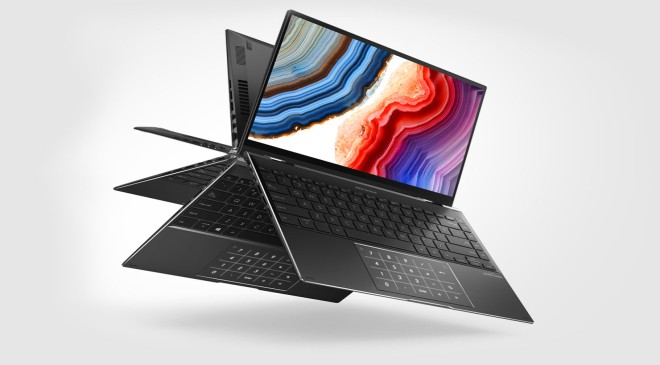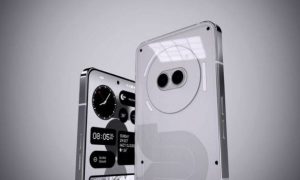Asus recently dropped two premium consumer notebooks in its ZenBook series. The Asus ZenBook 14 OLED and ZenBook 14X OLED Space Edition combine premium design with powerful specifications.
While the ZenBook 14 OLED Space Edition is a unique, one-of-a-kind laptop, our focus is on the more consumer-friendly ZenBook 14 OLED.
The Asus ZenBook 14 OLED arrives with a 12th Gen Intel processor, a 2.8K OLED display, a large 75Whr battery, and an all-aluminium design. The ZenBook 14 OLED’s starting price is Rs 89,990 and goes up to Rs 1,04,990 for our model.
Design & Build
The ZenBook 14 OLED is made of an aluminium alloy that is tough and features US MIL-STD 810H military-grade protection. However, the durable build doesn’t come at the cost of a compact design, weighing 1.39 kg and measuring 16.9mm thick. It also has a 180-degree hinge design that makes it easier for collaborative workloads. The notebook is being offered in Aqua Celadon and Ponder Blue finishes, while the lid has a reflective logo.
ASUS monogram logo. The ZenBook features a premium build that seems durable but that doesn’t take anything away from the design. The laptop looks stylish and is also highly portable. The ZenBook’s compact size makes it ideal for work on the go. I found the laptop particularly useful for work when travelling. The ZenBook 14 OLED features a thin and light form factor while being durable.
Ports
For a 14-inch notebook, the ZenBook has quite a few ports. The notebook features two USB Type-C ports with Thunderbolt 4 support, a USB Type-A port, a microSD card reader, a 3.5mm audio jack, and an HDMI 2.0 port. It also comes with Bluetooth 5.2 and wi-fi 6E connectivity.
Keyboard & touchpad
The ZenBook 14 OLED has the ErgoSense backlit keyboard with a large touchpad. The ErgoLift hinge lifts the keyboard deck, making it more comfortable to type on. The keys also boast a 1.4mm key travel distance, which the company claims is the “longest of any laptop in its class”. The keys are convenient to type, while the function keys make the keyboard easier to use.
The touchpad of the ZenBook 14 OLED (2022) has a large surface area that doubles as a NumPad, which Asus claims is NumPad 2.0. The touchpad has an LED-illuminated numeric keypad that doubles as a calculator. The touchpad is quite responsive, which makes it easy to navigate through the laptop. Overall, the keyboard and touchpad experience on the ZenBook 14 OLED was excellent, adding to the convenience while travelling.
Display
The Asus ZenBook 14 OLED has one of the best displays on a premium laptop. The notebook sports a 14-inch OLED panel with a 2.8K (2880 x 1800) resolution and a 16:10 aspect ratio. The ZenBook has a 10-bit panel with up to 550 nits of peak brightness and 100 percent DCI-P3 and 113 percent sRGB colour gamut. The laptop is also Pantone validated.
The screen is VESA DisplayHDR 500 True Black compatible to ensure excellent details with true-to-life colours. When it comes to entertainment, the display is the best in its class and if that isn’t enough, the notebook also sports a 90Hz refresh rate and a 0.2ms response time. The screen has also been certified by TUV Rheinland for hardware-based low blue light emission.
Audio
The ZenBook 14 OLED is equipped with stereo speakers and a Smart AMP. The sound is tuned by Harman Kardon and features Dolby Atmos support. While the sound is not out of this world, it is more than enough to fill a quiet room. I had to use external speakers when using the laptop at home but in a hotel room, the sound was loud enough for dialogues and vocals.
Performance
The ZenBook 14 OLED opts for a powerful 12th Gen Intel Core Core i7 1260P processor with 4 Performance cores and 8 Efficiency cores. The CPU features integrated Intel Iris Xe graphics as well as 16GB of LPDDR5 RAM. The processor has a minimum power draw of 28W and a maximum turbo power of 64W. For storage, there’s a 512GB M.2 NVMe PCIe 4.0 SSD. The 12th Gen Intel CPU makes multi-tasking on the ZenBook a breeze.
I wasn’t quite sold on general multitasking, so I ran an Android game (Raid: Shadow Legends) on Auto in the background. But despite a game running in the back as well as 10 tabs in Google Chrome and Microsoft Word running simultaneously, the ZenBook 14 OLED didn’t slow down. The fans did amp up to ensure no slowdowns in performance. The laptop also performed surprisingly well when multitasking on battery life. I found it easy to multitask when working on the go, even with a photo editor opened.
We also ran a couple of benchmarks, with the CPU scoring a multi-core score of 7,981 points and a single-core score of 1501 points. In Cinebench R23, the notebook managed a single-core score of 1491 points and a multi-core score of 6998 points. In the Cinebench 10-minute stress test, we saw the single-core score drop to 1,284 and the multi-core score drop to 6,213 points. I was also able to run Overwatch and DOTA 2 on medium settings in 720p resolution or 1080p resolution on medium settings.
Battery
The battery life on the ZenBook 14 OLED (2022) was more than sufficient to get through an entire workday. It packs a 75Whr battery and comes with 65W charging support over a USB Type-C port. The large battery was capable of delivering a full workday of usage on a single charge, which is roughly eight to nine hours, depending on your usage.
I used the laptop for work while travelling and only ended up burning 50 percent of the battery after using the laptop for about four and a half hours at a stretch. However, the laptop also supports Asus’ proprietary Easy Charge technology to ensure optimal charging speeds.
Camera
Unfortunately, the ZenBook 14 OLED uses an underwhelming 3DNR HD (720p) webcam, which is about average for video calls. Considering this is a premium laptop, I’d expected to see a 1080p webcam. The webcam also comes with a privacy shutter and AI noise-cancelling audio technology for calls. The new ZenBook 14 OLED also comes with a fingerprint scanner with Windows Hello authentication.
Verdict
The Asus ZenBook 14 OLED (2022) is your run-of-the-mill premium consumer notebook. The new ZenBook also ticks all the boxes of a premium laptop with its powerful yet efficient processor, a solid build with a compact design, excellent audio, and comfortable keyboard. The notebook also has the latest technology with PCIe Gen4 SSD, LPDDR5 RAM, Wi-Fi 6E, and its OLED display.
And since we’re on the topic of OLED displays, the new ZenBook has one of the best screens on I’ve seen on a consumer notebook. Additionally, it is also the smoothest with its high refresh rate. If you are looking for a premium notebook for everyday use or work on the go, then the ZenBook 14 OLED (2022) is worth considering.
The ZenBook also features Intel’s Evo certification, ensuring excellent power and productivity standards. One of the only drawbacks of the new ZenBook 14 OLED is its simplistic design. It may not hit the tall expectations of the ultra-premium notebooks but it also doesn’t come at an ultra-premium price. This makes the new ZenBook the most practical choice for consumers looking to buy a premium laptop.Start the conversation





































